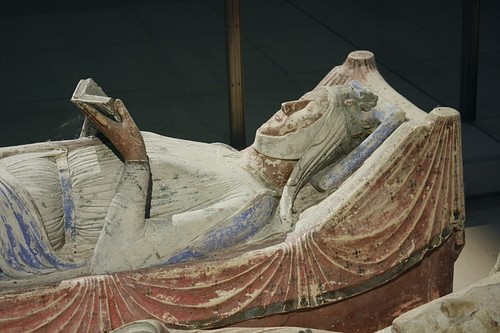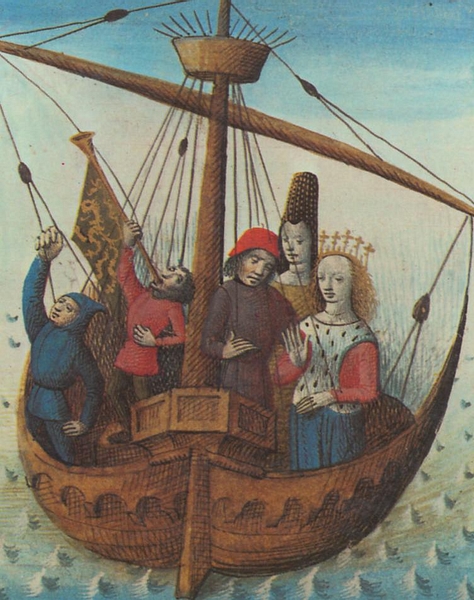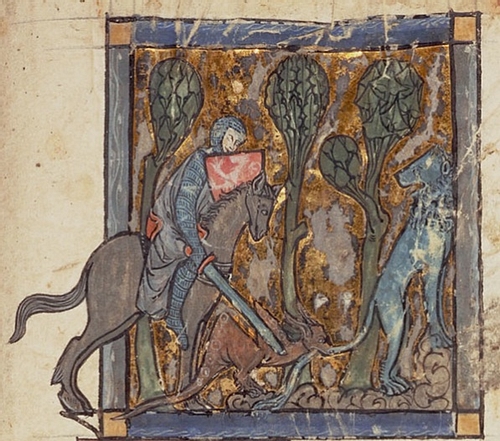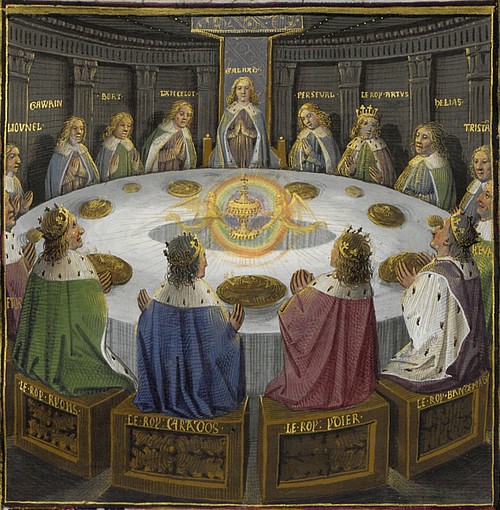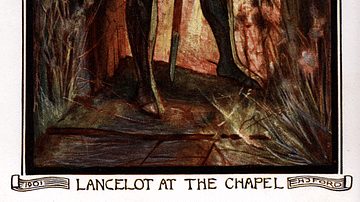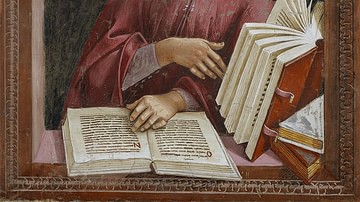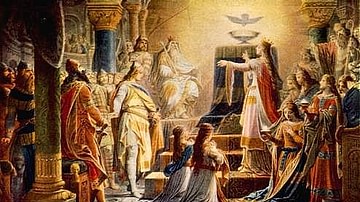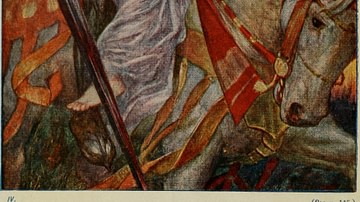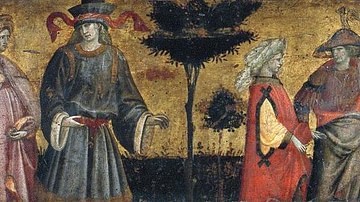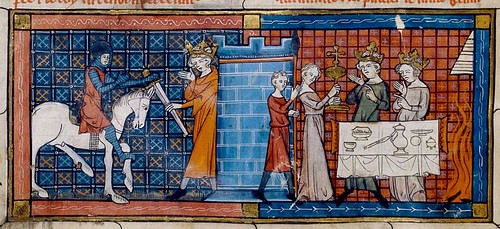
Chretien de Troyes (l. c. 1130-1190 CE) was the greatest romantic poet of his era, regarded today as the Father of Arthurian Romance (along with Geoffrey of Monmouth) and also Father of the Novel owing to his narrative form. He was most likely born in Troyes, in the Champagne region of France, and was patronized by Marie de Champagne (l. 1145-1198 CE), daughter of Eleanor of Aquitaine (l. c. 1122-1204 CE), well-known for patronizing the arts and encouraging the poetry of courtly love.
Chretien is the author of five Arthurian Romances:
- Erec and Enide
- Cliges
- Lancelot or the Knight of the Cart
- Yvain or the Knight with the Lion
- Perceval or the Story of the Grail
He was the first to introduce some of the best-known aspects of the Arthurian Legends such as the affair between Lancelot and Guinevere, the Grail Quest, and Camelot as the name of Arthur's court. Based upon details in the introductions to some of his poems, he also translated works from Latin and wrote other pieces which are now lost. Nothing is known of his life outside of his work, and even his name is unknown. 'Chretien de Troyes' translates as "a Christian from Troyes" which could refer to almost anyone of that city.
His writing career spanned c. 1159-1190 CE, during which time he was quite prolific even though only five, possibly six, of his works survive in the present day. He was a contemporary of the great French poets Marie de France (wrote c. 1160-1215 CE) and Bernard de Ventadour (12th century CE), both of whom were associated with Eleanor of Aquitaine. Chretien's works were popular reading in his time and continued to be, influencing the development of the Arthurian Legends for the next few centuries until the tales of Arthur in all the various traditions were collected, codified, and standardized by the English author Thomas Malory in 1469 CE.
The Romances & Courtly Love
Chretien is also credited for developing the medieval tradition known as courtly love, but what precisely courtly love was is still debated. According to some scholars, it was only a literary convention while others claim it was a social game of the medieval French courts and still others that the works were allegories of the heretical religious sect known as the Cathars.
However it originated, courtly love poetry was socially transformative, at least for the upper classes. Throughout the Middle Ages (c. 476-1500 CE), women were regarded as second-class citizens, often as little more than the property of the lord of the fief they lived on, their father's, or their husband's. During the High Middle Ages, however, c. 1000-1300 CE, women's status markedly improved – at least for those of the emergent middle class and the aristocracy – and this shift seems due, at least in part, to the influence of courtly love poetry.
This genre of medieval literature appears seemingly out of nowhere toward the end of the 11th century CE in Languedoc (Southern France) and was developed fully during the 12th century CE. Scholar C. S. Lewis describes the most innovative aspects of the genre:
The sentiment, of course, is love, but love of a highly specialized sort, whose characteristics may be enumerated as Humility, Courtesy, Adultery, and the Religion of Love. The lover is always abject. Obedience to his lady's lightest wish, however whimsical, and silent acquiescence in her rebukes, however unjust, are the only virtues he dares to claim. It is a service of love closely modelled on the service which a feudal vassal owes to his lord. The lover is the lady's 'man'. He addresses her as midons, which etymologically represents not 'my lady' but 'my lord'. The whole attitude has been rightly described as 'a feudalization of love'. (2)
How closely early courtly love poetry reflected the actual relationships of the French nobility is still debated, but there is no denying the highly refined poetry of writers such as Chretien influenced the way women were perceived toward the end of the 12th and into the 13th centuries CE. The only qualifier here is the influence of the formidable Eleanor of Aquitaine who set a standard of the female monarch which would be modeled by her daughter Marie de Champagne (from her first marriage to Louis VII of France) as well as her daughter Eleanor of England (l. c. 1161-1214 CE, from her marriage to Henry II of England) and granddaughter Blanche of Castile (l. 1188-1252 CE) who influenced their own times and regions. It should be noted, however, that Eleanor of Aquitaine's life and passions are intimately entwined with the development of courtly love poetry and so the two could be seen as exerting exactly the same sort of influence at precisely the same time.
The type of poetry described above by Lewis was a completely new vision of women in the Middle Ages, and there seems no avoiding the evidence of Eleanor's life as influencing the development of this genre, even though this point is continually debated among modern-day academics. Like the character of the lady in courtly love poetry, Eleanor refused to be defined by her relationship with men, consistently took control of any given situation and, like one of the heroines of the poetry of Marie de France, saved herself from problematic situations far more often than she was saved by another. Chretien, writing for Eleanor's daughter, presents his women as strong characters who dominate the narrative. Chretien's women direct the action in a piece even when they appear in a submissive role.
Erec and Enide
Chretien's first romance is his Erec and Enide (c. 1170 CE) focusing on Erec, one of Arthur's knights. As the poem begins, Erec is among those guarding Guinevere as she observes a hunt. A strange knight and a dwarf come past and insult the queen who orders Erec to follow him and find out his identity.
Erec follows him to a far-off walled town and finds he is known as Yder and, at the same time, sees the lady Enide and falls in love with her. When he hears a tournament is being held to win a falcon as a prize for the most beautiful woman in town, Erec signs up, defeats Yder, and claims Enide for his wife. They return to Arthur's court, where Enide's beauty and nobility are so impressive – in spite of the poor-quality clothing Erec had her wear – that she is instantly welcomed. Guinevere herself even gives Enide one of her best dresses.
Erec is so in love with his wife that he neglects his duties as a knight, and Enide, upset at being the cause of this lapse, cries over it. Erec is ashamed and orders his wife and entourage to follow him on a quest to redeem himself. The couple then experiences a number of perils and adventures in which Erec proves himself. He and Enide are crowned monarchs of a far-away kingdom and presumably live happily ever after.
Throughout the poem, Enide is a strong, independent, and fully-realized character. She is no mere prize for the knights at tournament nor a meek and retiring wife to her husband. Even when commanded to remain silent on their journey, Enide still speaks out and repeatedly saves Erec from danger.
Cliges
Chretien's second work, Cliges (c. 1170's CE) continues this theme as the heroine, Fenice, contrives the means of saving herself and her lover. Cliges is an intricate reworking of the Tristan and Isolde romance in which a young knight falls in love with his uncle's fiancé. The first part of Cliges focuses on Cliges' father, Alexander, a young Grecian prince who comes to King Arthur's court in Britain to prove himself and be knighted. While at court, he meets Arthur's niece, Soredamors, and falls in love but is too shy to talk to her and Soredamors is in the same predicament. The two lovers are encouraged to share their feelings by Queen Guinevere, get married, and Cliges is born.
Alexander and his family return to Greece, where his brother, Alis, has assumed the throne. Soon after, Alis decides to marry the princess Fenice of Germany and, when she arrives, she and Cliges fall in love at first sight. Cliges does not want to betray his uncle and so he leaves, returning to Arthur's court, where he becomes one of Arthur's knights and goes on various adventures. When he returns to Greece, he finds that his feelings have not changed for Fenice, nor hers for him.
Fenice does not want to be like Isolde who "gave her heart to one man but her body to two" but cannot bear to be without Cliges. She solves the problem with a potion which makes her appear to be dead and Cliges takes her away to a secret tower. The lovers are happy in their hideaway until they are discovered. Cliges goes to Arthur for help in recovering Fenice, but Alis dies while he is in Britain, and the story ends with the lovers reunited.
Lancelot or the Knight of the Cart
Chretien's Lancelot (c. 1177 CE) is his best-known work and the first Arthurian piece to introduce the now-famous love affair between Lancelot and Arthur's wife Guinevere. Chretien left the manuscript to work on something else (possibly Yvain) and it was completed by his clerk Godefroi de Leigni (12th century CE) who presumably worked with Chretien in his study. The story opens with Guinevere abducted by the evil lord Meleagant and Arthur's knights sent in pursuit. Among them is Lancelot who outdistances the rest but his horse finally gives out and dies. Lancelot continues on foot until he meets a dwarf driving a cart who says he knows where Guinevere has been taken and will help if Lancelot consents to ride in the cart. Carts were associated with criminals and the lower class and so Lancelot, greatest of Arthur's knights, hesitates for a moment before getting in.
As the knight and the dwarf travel on, Lancelot is mocked and humiliated for riding in the cart but finally reaches the tower where Guinevere is held and rescues her. She rebukes him, however, for his hesitation at the cart; he placed his own honor and how others might see him above his devotion to her. In trying to free her, Lancelot is imprisoned by Meleagant but is freed by a woman he helped earlier. To win Guinevere back, Lancelot agrees to lose against inferior opponents in a tournament until Guinevere tells him to win. He emerges the champion of the tournament, kills Meleagant, and is rewarded with a courtly embrace by Guinevere.
Chretien mentions Lancelot in his earlier works but does not develop the character in any way until this piece. The character is entirely Chretien's creation as he appears in no Arthurian tales prior. Guinevere was already an established character following Geoffrey of Monmouth's History of the Kings of Britain (1136 CE) but her relationship with Lancelot and her temperament first appear in Chretien's work. Lancelot or the Knight of the Cart is the poem which first inspired the term 'courtly love', coined by the French writer Gaston Paris in 1883 CE who was writing on the piece.
Yvain or the Knight with the Lion
In Yvain (c. 1180 CE), Chretien at first seems to invert the central theme of courtly love poetry – the knight abjectly serving his lady – but that turns out to be the subject all along. Yvain is a young knight of Arthur's court intent on avenging the honor of his cousin Calogreant who was defeated in single combat by Esclados, Knight of the Fountain. Yvain kills Esclados but then falls in love with his wife Laudine. Laudine wants nothing to do with the man who murdered her husband, but Yvain wins the trust of the lady's maidservant Lunete, who convinces Laudine to marry him.
Yvain's friend, Gawain, thinks he is too young to stay at home as a married man and convinces Yvain to go adventuring with him. As she has only just gotten married, Laudine strongly objects but Yvain promises her he will not be away long and she agrees he can have a year to get this out of his system. Once he leaves, however, he is swept up in adventures with Gawain in far-off lands and forgets Laudine and his promise of only a year away. When he returns, she rejects him and he falls into despair which leads to madness.
He is cured by a noble lady and vows to prove himself worthy of Laudine through even greater challenges than those he had met with Gawain. As he sets out, he finds a lion trapped by a dragon; he kills the dragon and frees the lion who then becomes his constant companion. The knight and the lion go on to triumph over multiple opponents and also rescue Lunete who had been taken and was to be killed. Laudine forgives Yvain and welcomes him and the lion back to court.
The Yvain draws on the themes of earlier Arthurian Legends as well as folktales (such as Androcles and the Lion), but Chretien makes the story his own through careful characterization and development. The hero-knight who wins his lady, only to forget her by 'going off with the guys', was a completely new motif in Arthurian literature and an interesting spin on the traditional image of the knight completely devoted to his lady – even though that is precisely who Yvain becomes in the end.
Perceval or the Story of the Grail
Chretien's Perceval (c. 1190 CE) was left unfinished, most likely due to the author's death. The poem is dedicated to Philip I, Duke of Flanders (r. 1168-1191 CE) who was then Chretien's patron and died in 1191 CE. Four unknown poets continued the Perceval in the sections known as the Four Continuations which are not as high quality as Chretien's work but in no way detract from the original narrative's brilliance. Scholar Norris J. Lacy writes:
Chretien's final romance, though uncompleted, was enormously influential: it introduced the Grail into world literature and made this object (which was a marvelous and holy vessel but not yet, in Chretien, the chalice of the Last Supper) the focus of a quest. (Lindahl et. al., 77)
Perceval is raised in the woods by his mother with no contact with the outside world until one day when he sees some knights ride by. He instantly knows he must become one and goes to Arthur's court to learn how. He is not there long when he is insulted by Sir Kay and swears revenge. All of his subsequent adventures are to prove himself Kay's better.
He trains under the tutelage of the knight Gornemant who instructs him not only in feats of arms but the chivalric code, including the importance of not showing one's mind by speaking too much. On one of his adventures, he meets the Fisher King (also known as the Grail King) who invites him to his castle. While there, Perceval witnesses a strange procession in which certain objects (a bleeding lance, a candelabra, a grail) are carried but, remembering Gornemant's training, he does not ask what it all means. When he wakes up the next morning, everyone in the castle is gone and he is left alone to saddle his horse and ride on. Sometime later, he meets a weeping woman who rebukes him for not asking what the procession meant because, had he done so, he could have healed the Fisher King and restored the land.
His failure to ask the question continues to haunt him in his following adventures as a "loathly lady" condemns him for his failure. She turns her attention from him to the rest of the Knights of the Round Table, foretelling great adventures which await them, as Perceval quietly leaves the court to begin his quest for the grail and, at this point, Chretien's work ends. The Four Continuations all attempt to complete the story and tie up any loose ends and the story finally concludes with Perceval succeeding the Fisher King, reigning justly, and retiring to live in solitude in the woods as a hermit.
Conclusion
Chretien also wrote a version of Tristan and Isolde, now lost, which he claims was not well received but his extant works were bestsellers in their time. Norris J. Lacy writes:
So successful was he that a good many writers of the following generation appear to have deliberately avoided Arthurian subjects, no doubt understanding that they could not favorably compete with the master on his own literary turf. (Lindahl et al., 77)
Chretien's poetry only grew in popularity after his death, influencing the works of later Arthurian writers. The German poet Wolfram von Eschenbach (c. 1170 - c. 1220 CE) drew on Chretien's Perceval to write his Arthurian masterpiece Parzival and the impressive Welsh Mabinogion (c. 1200 CE) also bears traces of Chretien's inspiration. Chretien's Arthurian tales were further developed in the Vulgate Cycle (1215-1235 CE) which was the main source for Thomas Malory's Le Morte D'Arthur (c. 1469 CE), the crowning piece of Arthurian literature, considered the first novel of the western world; but what would that work be without Lancelot, Guinevere, and Grail?
